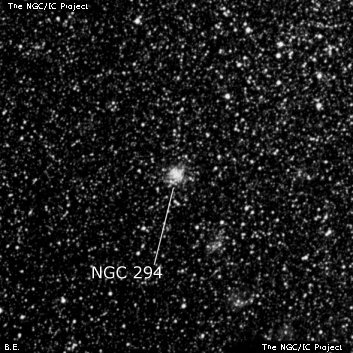
James Dunlop discovered NGC 294 = D 5 = h2358 in 1826 with his 9" reflector and reported "a small faint nebula, about 10 or 12 arcseconds diameter." His position is 5' due north ESO 029-022. D 6 described as "a faint nebula, about 20" diameter" was placed only 5' SE, and may be a duplicate observation.
John Herschel first observed this nebula on 11 Apr 1834, noting "eF. In a sweep below the Pole." He added a note later that "This obs give 47 -- instead of 46 -- for the min of RA. The earlier minute preferred." On a later sweep, he recorded the RA minute as 46, which was used in the GC and NGC but this is 1.0 min too far west. JH referenced D 5 as the discovery.
Pietro Barachhi observed this cluster on 16 and 17 Dec 1887, along with a number of other SMC clusters with the 48" Melbourne telescope. He described NGC 294 (labeled as "N") as "pB, pL, R, gbM. N follows M [Bruck 67, which he discovered] by 18 seconds and is 2' north of it."
The Hodge-Wright SMC Atlas labels NGC 294 as Lindsay 47, though Table 6 suggests NGC 294 = L47?
600/800mm - 30" (11/6/10 - Coonabarabran, 264x): fairly bright, fairly small, round, 45"-50" diameter, contains a bright core. The halo has a smooth moderately high surface brightness but there were no resolved stars. Four mag 12-13 stars forming a parallelogram are centered 4.5' NW, but there are no bright stars in the immediately field. Bruck 67, a slightly smaller irregular glow with a low surface brightness, lies 2.2' SW. NGC 267 lies 23' WNW.
Notes by Steve Gottlieb